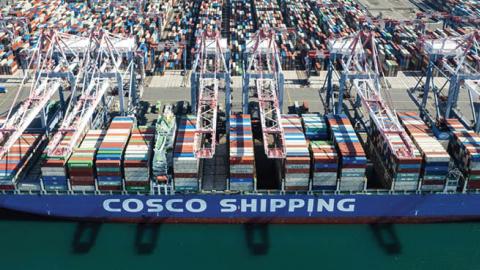It is often stated that America is a maritime nation given its vast coastlines on the largest oceans and the world’s most powerful navy and coast guard. America also boasts robust commercial shipping and shipbuilding capabilities to serve its domestic economic and security needs.
But when it comes to international shipping, America is not a maritime nation. We import more goods than any country in history, yet almost none of them move on American ships controlled by American companies and built in the United States. In contrast, China’s manufacturing and export economy, coupled with strategic government interventions, has produced a commercial shipping and shipbuilding powerhouse. China has around 1,200 large commercial ships under construction, compared to just a handful in the US. China owns more than 7,300 large commercial ships, a third more than second-place Greece and four times the number owned by Americans. About 5,000 large commercial ships fly the Chinese flag vs. fewer than 200 flying the US flag.
The comparatively small size of America’s commercial maritime industry creates significant vulnerabilities in a great power competition with China. The most prominent concern is sealift: whether we have the scale and scope of maritime resources to resupply American troops effectively in a military contingency overseas. The vital role of logistics in winning or losing a war has been on full display in Ukraine, as the Ukrainians’ ability to disrupt Russian supply chains has been decisive in their successes so far. While land-side logistics is the dominant focus in Ukraine, maritime logistics would be front and center in a Western Pacific conflict.
Existing American sealift capabilities (commercial and government mariners and ships) are barely sufficient to cover surge and sustainment needs in the Western Pacific, even under favorable operating assumptions. Further, as we consider the extraordinary military and commercial maritime resources available to China, we should build a healthy cushion into our operating assumptions. We should not assume perfection in our ability to predict what China would do, nor in our ability to execute our plans. Also, our ability to quickly scale up our sealift capacity is in serious doubt given the size of America’s commercial mariner and shipbuilding industrial base. China is fully aware of these limitations, which diminishes our credibility as we attempt to deter certain types of military provocations, including the many aggressive actions we have seen for more than a decade in the South China Sea as well as the potential of an attack on Taiwan.
China’s dominant and growing control over international shipping and trade is of potentially greater concern when it comes to sustaining America’s economic competitiveness and independence. Although war with China may never come, the absence of American ships and lack of American control over our international maritime logistics supply chain have left American consumers and businesses vulnerable. This has been made abundantly clear during the supply chain crisis of the last two years, in which a sevenfold increase in international container shipping rates has pushed general inflation up by at least 1.5 percent. Virtually all of that profit has gone to Chinese and other foreign carriers, while American carriers have kept rates stable in US domestic markets.
Specific behaviors by foreign-owned shipping lines are of particular concern, such as the practice of leaving behind US exports in order to reap larger profits by turning shipping containers back to China as fast as possible for the more lucrative eastbound trade. Further, because China manufactures more than 95 percent of the world’s shipping containers, it has the power to leverage access to and information from those containers to its benefit and America’s detriment. Also, China’s Belt-and-Road Initiative (BRI) includes strategic investments in seaports around the world in addition to robust development of China’s home ports. This enables the Chinese Communist Party to exert political and economic leverage that could be adverse to American interests. While America’s ports are strategic geopolitical assets, many are dealing with vulnerabilities caused by decades-long underinvestment at the federal level, and there is no long-term strategy to leverage America’s port industry to help counter BRI.
These asymmetries show that America’s dependence on foreign ships and foreign maritime logistics providers creates unacceptable vulnerabilities in peace and in deterring war. In short, China’s comprehensive maritime strategy is working. As its market power in the maritime sector continues to grow, so too will America’s vulnerability.
America has no policy response, no strategy to mitigate these vulnerabilities. On the assumption that great power competition was over or that the commercial maritime industry would be irrelevant to winning such a competition, America has for decades made policy choices that disadvantage its own commercial maritime interests. Openly granting “flag of convenience” vessels complete access to carry American international cargo was the original sin. It forced US flag vessels with American mariners to compete head-to-head with ships that met minimal safety and environmental standards and had virtually no enforceable obligations to the ships’ crews. This explains why, even today, the world’s leading ship registries are Panama, China, Liberia, and the Marshall Islands. Further, American shipping companies operating in international markets faced a yawning tax disadvantage that helped push the largest American carriers to sell their businesses to foreign carriers. Support for American shipbuilders unilaterally ended forty years ago, while foreign governments continued and expanded various support programs. Estimates are that China in recent years has provided at least $15 billion annually in financial support to its shipping and shipbuilding sector.
Fortunately, we’ve kept those disadvantages out of our domestic markets by insisting that those who compete to provide maritime transportation between American points must hire American mariners, obey American laws, and pay American taxes. As a result, we have a diverse and substantial domestic maritime industry with modern ships built and operated by American citizens to US standards. Competition in our domestic markets has led to American innovation, sometimes with global effect, from containerization itself to LNG-powered cargo ships. Our domestic tanker fleet operates at world-class standards for safety and reliability and is roughly three years younger than the global tanker fleet. Containerships serving domestic trades are customized for efficiency as compared to those serving international trades.
Meeting market demand for domestic shipping keeps us in the game, providing enough work to maintain a critical mass of American shipping and shipbuilding capabilities so that we have something to scale up if needed. But as large and diverse as US domestic maritime markets are, they are dwarfed by international maritime markets. As international shipping has grown, and given the damage done by decades-long policy disadvantages imposed on American maritime interests, the gap between American and foreign commercial maritime capabilities—particularly those of China—has continued to grow.
Russia’s invasion of Ukraine demonstrated the importance of maintaining American energy independence. Similarly, the rise of maritime China should make us sit up and take notice of the need to achieve American independence and security over our international supply chains, starting with the ships that are at the heart of global trade. Given our near-total reliance on foreign ships and shipping companies today, the challenge of deploying a winning strategy to achieve supply chain independence is radically different from that of maintaining American energy security. Existing programs that support the US maritime industry are extremely limited and were designed to offset the effects of a policy foundation that fundamentally disadvantages American maritime interests. While vital and effective, they support only a handful of US flag vessels competing internationally (less than 100 in a global fleet of 50,000) and seem inadequate given the scope of our vulnerabilities. And these programs were designed with sealift in mind and do little, if anything, to address other concerns, including our shipbuilding industrial base and peacetime vulnerabilities in our maritime supply chain.
Simply put, we need a comprehensive overhaul of our international commercial maritime strategy with the goal of achieving American independence and security over our international maritime supply chains. It would include phasing out the flag-of-convenience system and replacing it with a system based on robust operating and social standards that includes security and economic considerations in granting carrier access to our import-export markets. We would fully unwind tax and other disadvantages, and introduce balanced measures, so that American-owned shipping companies can compete on a level playing field to carry America’s foreign trade. We would develop and fund a comprehensive national strategy to support American commercial shipbuilding and supplement the work provided by domestic markets. We also need a thoughtful and aggressive strategy to address concerns raised by Chinese investments in strategic ports around the world. Finally, we should develop policy incentives to help Americans diversify product sourcing decisions, including bringing more manufacturing onshore to America and near-shore to our neighbors in the Western Hemisphere.
If we had correctly assessed the threats posed by China and the importance of American independence and security over international supply chains when the Cold War ended, we would likely have made fundamentally different policy choices along the way. While we cannot go back in time and change those decisions, we also cannot ignore that they leave us vulnerable. Circumstances are different today and demand that we make new policy decisions that advance American security as well as trade interests. American commercial shipping, shipbuilding, labor, and port interests have a critical role to play in developing and implementing a winning strategy. It is time to scale up!















